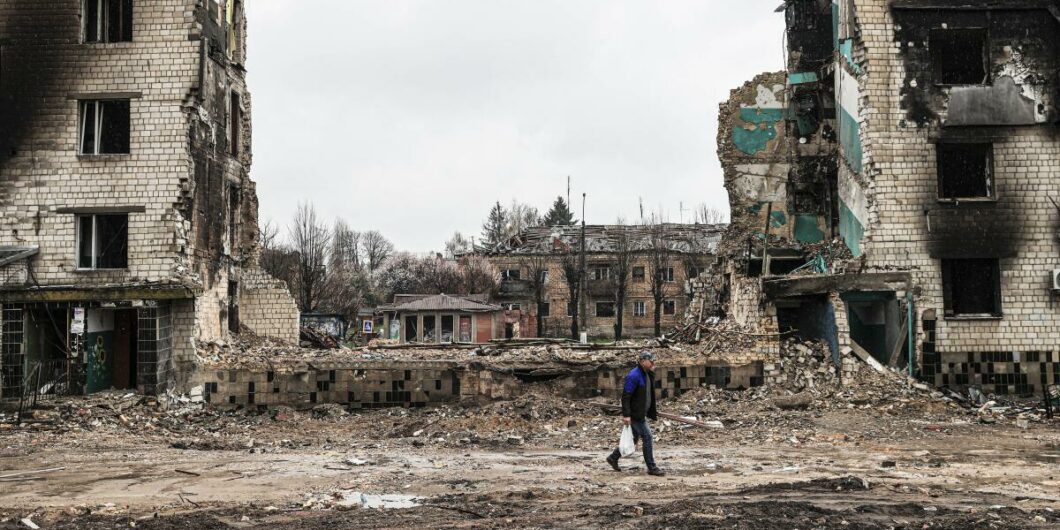“On the Balance of Power” recognizes that just causes are often pushed too far.
The Consequences of Good Intentions
Between the ongoing war in Gaza and Houthi attacks on Western shipping in the Red Sea, the media has had plenty of gruesome foreign policy fodder for the content mill. However, this coverage has come at the expense of the ongoing grinding conflict in Ukraine, which has quickly gone from a euphoric cause célèbre to a now embarrassing catastrophe that is best shoved in the closet and forgotten like all the rest of America’s decades of costly foreign policy disasters.
In recent weeks and months, the tone of coverage around the ongoing war in Ukraine has changed. At one point, any Russian advance was treated as a fluke and any Ukrainian success was seen as the precursor to an inevitable victory. The tone has now decidedly shifted, however, toward a more pessimistic view of Ukraine’s prospects and the fulfillment of NATO/Western goals. We wrote in a previous piece that time was not on Ukraine’s side. Now it appears that the mainstream press is starting to come around to the same conclusion.
Whereas before any suggestion that Ukraine would achieve anything short of total victory against Russia was met with howls of protest and vitriolic accusations of being a Kremlin stooge, mainstream outlets have begun to openly acknowledge the writing that has been on the wall for quite some time.
Near the beginning of the war, the Russian troop columns had taken almost the whole of Novaya Rossiya and were putting pressure on Kiev. Amid this offensive, a delegation from Ukraine met with Russian counterparts in Turkey to discuss a possible end to the conflict. The US assumption seems to have hedged on the idea that the Russian government would not survive a sustained conflict against the might of NATO supplies and Ukrainian strength of arms. The question remains how likely it was that Russia would cave under the sanctions pressure it was under.
From the actions of the Russian government at the beginning of the war it has been convincingly argued that Russia did not intend to invade and conquer Ukraine for annexation, let alone continue on a rampage into the rest of Eastern Europe. Rather, the invasion’s goal was to have a show of strength and rapidly coerce Ukraine away from joining NATO and to secure the interests of Russian people living in Ukraine. It is arguable that when negotiations broke down in March of 2022 they moved forward with a more direct goal of annexing key regions of strategic interest that contain more Russian speakers and ethnics. For much of Ukraine’s history, these southern and eastern regions formed the backbone of pro-Russian sentiments in the Ukrainian government. However, the war has changed these attitudes in a myriad of ways. It was argued that in the leadup to the fighting the nearly 130,000 troops that Russia allocated in the first months of the war were not enough to pacify the whole country even if it was the goal.
However, as has now become unmistakably clear, the US and UK quashed these negotiations, and Ukraine, quite disastrously in hindsight, complied and declared nothing short of total victory, including the reclamation of Crimea, would be acceptable. In response, Russia realized that to win the war, Ukraine would have to be effectively neutralized by force and began to annex oblasts and incorporate them into Russia proper, effectively burning the ships behind them and ensuring that it was going to be invested in the conflict for the long haul.
At the beginning of the war, Ukraine was able to achieve success against overstretched Russian forces who were not prepared at the time to fight a drawn-out war of attrition. This in turn induced visions of further Ukrainian breakthroughs that would cause the Russian military to collapse and even potentially Putin’s government. However, these Ukrainian victories were never against well-prepared and fortified Russian positions. As the failed counter-offensive has demonstrated, Ukraine has thus far been unable to make gains against the Russian army when at parity.
In the year since that counter-offensive, the situation has turned against Ukraine in ways that were not difficult to foresee. The US and the West scraped the bottom of the barrel to outfit Ukrainian forces for the counter-offensive that in the end achieved nothing other than depleting manpower. To quote a former US official, “We built up this mountain of steel for the counteroffensive. We can’t do that again. It doesn’t exist.” Or in the words of NATO’s most senior military official, Admiral Rob Bauer, “The bottom of the barrel is now visible.” As the authors previously noted, the West is woefully unprepared to wage a modern war of attrition in Ukraine.
Western stocks were already facing shortages and production shortfalls, but thanks to the outbreak of the war in Gaza there is additional pressure that has seen ammunition earmarked for Ukraine rerouted to Israel instead. Furthermore, at the time of writing, Congress has not passed supplemental funding for Ukraine, even after returning from Christmas break. This means that not only is Ukraine not receiving what little American military aid it might hope to get, but it is also rapidly running out of funding to continue the functions of the rest of its state apparatus. Everything from firemen to pensions has been paid for by American aid that has now dried up.
The war in Gaza is hardly the only conflict competing for limited American resources. Numerous other potential crises loom on the horizon, ranging from further escalation in the Middle East due to attacks by Iranian proxy groups, pirate-style terrorist attacks on Red Sea shipping by the Yemeni Houthis, growing military escalation on the Korean Peninsula, and the potential Venezuelan invasion of Guyana in America’s backyard. Not to mention, America’s growing great power rivalry with China and the potentially devastating conflict over Taiwan that conflict entails. With so much chaos, Twitter activists are running out of room for flag emojis in their bios.
Commentators and scholars have long warned that the West would end up leaving Ukraine out to dry and were ignored for years, but increasingly such warnings appear prescient.
Internal Fractures
Meanwhile, European goodwill towards Ukraine has been collapsing. Perhaps even more notable than the stalled American aid package has been the collapse in relations between Poland and Ukraine, with the President of Poland comparing Ukraine to a drowning person who risks pulling its rescuer down with it. Polish truckers have even taken to protesting at the border to stop Ukrainian grain exports from undercutting their businesses. Additionally, recent European elections have seen a rise in support for parties and leaders that are on the record as opposing further aid to Ukraine, notably the election of Robert Fico as Prime Minister in Slovakia, and the unexpected electoral success of Geert Wilders in the Netherlands.
Ukraine’s increasingly dire situation has not been lost on its leadership, which has now begun to openly feud amongst itself. According to Time Magazine, one of Zelensky’s closest aids stated that “he deludes himself” with talk of retaking the pre-2014 borders, and another states that corruption has continued unabated and that “people are stealing like there’s no tomorrow.”
At the beginning of December, former Ukrainian president, and Zelensky rival, Petro Poroshenko’s papers were canceled, and he was prevented from leaving the country to meet with foreign leaders. Another rival, Kyiv mayor Vitali Klitschko, has accused Zelensky of turning into an authoritarian and of centralizing power in the country to such an extent that “at some point, we will no longer be any different from Russia, where everything depends on the whim of one man.”
Also concerning is the rumored rift that has now found its way into the public eye between Zelensky and the (now former) commander of the AFU General Zaluzhny. This has come about seemingly over their differing assessments of the state of the war. In an interview published by The Economist on November 1, 2023, Zaluzhny stated that the war had turned into a stalemate. Zelensky was quick to insist that this was not true, despite the abject failure of the summer counter-offensive to achieve anything.
Days later, on November 7, 2023, one of Zaluzhny’s aides was killed under unusual circumstances when he was opening birthday presents with his son and somehow set off a grenade. There are multiple accounts of what transpired, but as the BBC notes, “The official cause of the explosion has been questioned by Ukrainian commentators, some of whom have speculated whether it was an attack targeting Gen Zaluzhny himself, on the assumption that he might have attended his aide’s birthday celebrations.”
Speculation aside, Ukrainian media reports that Zelensky is suspicious of Zaluzhny’s potential political aspirations and that in addition to making political appointments to the military, he is also circumventing Zaluzhny in the chain of command to avoid his loyalists and instead deal with those loyal to Zelensky. This pessimism within the government also seems to have reached Zelensky himself who has been quoted by the critical Russian media agency, The Moscow Times, that he “no longer sees an end in sight” and is turning down requests from the army to mobilize as many as 500,000 men which will surely make his already precarious position even harder to maintain. At the time of writing, the long-standing feud between Zelensky and Zaluzhny has resulted in the firing of the latter. Time will tell how this will affect the Zelensky government as Zaluzhny ranks as one of Ukraine’s most trusted public officials.
No Foreseeable Future
On June 8, 2016, John Mearsheimer was on a panel at the Atlantic Council on the subject of NATO enlargement and Russia where he warned that “these policies [NATO expansion and integration] are leading the Ukrainians and the Georgians down the primrose path, because on one hand, we are provoking the Russians, causing all sorts of problems, giving them the incentive to do damage in Georgia and Ukraine and the idea the West is going to come to their rescue, you believe much too much in the United States.”
Negotiations that were scotched in early March of 2022 offered the possibility that Ukraine might have been able to survive with some semblance of sovereignty intact. Now Russia is likely unwilling to accept a Minsk III deal. With their annexation of the Novaya Rossiya region, they are signaling that this struggle will be one of total victory. Russian government ministers like Sergei Shoigu have stated that the war has been planned out at least until 2025. Furthermore, with the recent Russian victories around the Ukrainian stronghold of Avdiivka, there is growing doubt amongst observers that Ukraine can successfully resist Russian advances even at some of the most heavily fortified cities along the contact line.
Commentators and scholars like Mearsheimer have long warned that the West would end up leaving Ukraine out to dry and were ignored for years, but increasingly such warnings appear prescient. Some Ukrainians have woken up to this grim reality. As former Ukrainian presidential advisor, and now Zelensky rival, Oleksii Arestovych recently remarked, “In the conflict of globalists and realists, we made a bet on the wrong side. We shed blood to end up in the losing camp.” Hopefully, it is not too late to salvage an acceptable compromise and forge some semblance of peace, but that means accepting the reality of Ukraine’s untenable position.



